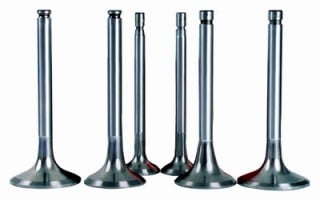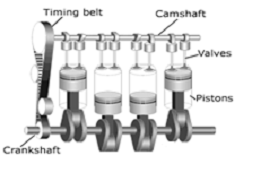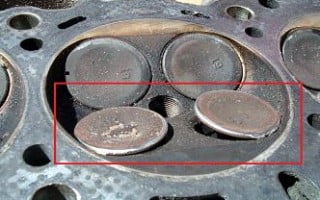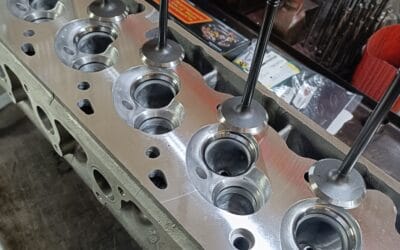
The valves in your cylinder head are a vital component of your engine and undergo enormous stresses, opening and closing up to 2500 times every minute under normal operating conditions. When one or more of these valves are damaged, the result can be anything from reduced power and poor fuel consumption, to complete engine failure. The two most common types of valve failure are bent/broken valves and burnt valves.
Bent Valves
The most common failure of valves is bending or breaking as a result of contact with the pistons. The valves contacting the top of a piston is due to incorrect engine synchronization caused by timing chain/belt breakage and incorrect fitting of new belts and chains. If you suspect your engine may have bent or broken valves, it is crucial not to attempt to start the engine as this may result in more costly damage being caused to the cylinder head, pistons and cylinder bores.
The bent valves above are a result of a fatigued timing belt that has broken. Your timing belt doesn’t last forever and needs to be replaced according to the manufacturer’s service guidelines. Replacing your timing belt is cheap insurance against costly engine damage.

Burnt valves
The other common type of valve failure is valve burn, or burnt valves. Essentially this is caused by combustion gases escaping between the valve and valve seat when they are not sealing correctly. The hot combustion gases are forced past the valve which starts to burn away the edge of the valve, progressively getting worse the longer it is left without being rectified. Normally this type of failure affects the exhaust valves only, but it can also damage the intake valves.
A burnt valve will cause issues with your vehicle’s performance and fuel consumption. Rough idle, reduced power, backfiring, and misfire are all symptoms of valve burn. If your engine is showing symptoms like these, we recommend you get your car checked by a trusted mechanic, as continual driving with a burnt valve will cause more damage to your engine, and will in turn cost more to repair in the long run.
Possible causes of burnt valves are:

- Excessive localized heat
- Combustion gases escaping past the valve and concentrated at only one point
- Irregular valve sealing with cylinder head valve seat. Carbon residues generated by irregular combustion (poor mixture) will appear at the seat region and will jeopardize the sealing between the valve and its seat
- Deficient refrigeration is another factor, due to partial obstruction of the cylinder head cooling. As a consequence, the valve is cooled inadequately
- Incorrect valve clearance can jeopardize the valve sealing and also cause this type of failure
- Running a dry fuel such as L.P.G resulting in inadequate lubrication of the valve seat, causing the valv

e seat to fail and consequently, the valves
To help prevent this type of failure, there are a few things you can do. Maintain a clean, efficient cooling system so the engine does not run too hot, use good quality fuels to help prevent carbon build up on the valve seats, and have your mechanic regularly check the valve clearances are within specifications.
If your vehicle is using an aftermarket L.P.G fuel system, you must check that the engine is L.P.G compatible (most are NOT). In the event your engine is running L.P.G but is not L.P.G compatible, valve failure is imminent. It will generally be less costly to have your cylinder head removed and modified for L.P.G before the valves start to burn, rather than wait until the damage is done. Once the L.P.G modifications are complete, it will be safe to use the L.P.G without damaging your engine.




